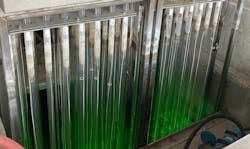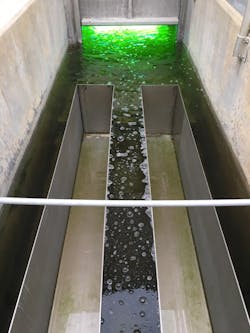Water & Air UV Treatment
Bak Srikanth is manager of applications and project proposals at Aquafine Corp. He has been with Aquafine since 1994, where he previously was senior applications engineer. He manages all applications engineering, process R&D and capital project proposal functions. He has several years of work experience in the water treatment and purification industry. He may be reached at 800-423-3015, ext. 651; [email protected].
David Witham is vice president of new technology at UltraViolet Devices, Inc. where he has been since 1996. Previously, he was director of engineering. He is responsible for developing UV technology, intellectual property and new business opportunities. Witham has spent a large portion of the last three years in developing the application of UV in indoor air as well as special water applications and the development of modeling and software to assist in UV dosing and system design. He may be reached at 661-295-8140; [email protected].
undefinedUltraviolet (UV) light represents a powerful technology that has been deployed successfully in several diverse industries for decades. The four-part series recently published in WQP explained the basics of UV disinfection and systems design. It discussed the excellent applications in municipal water treatment plants.
UV is an accepted and rapidly growing technology for treating wastewater in the United States. In Europe, it commonly is used as a primary disinfectant in municipal drinking water systems. Other applications include food and beverage, pharmaceutical, semiconductor and power generation. This article will discuss three other commercially successful and growing applications.
While the most common application of UV radiation in water treatment is disinfection, its powerful energy also can be harnessed for other applications such as chlorine destruction and breaking down ozone into harmless by-products.
The use of UV technology for water treatment has several inherent advantages over most traditional technologies. UV radiation does not add anything to the water stream such as undesirable color, odor, chemicals, taste or flavor, nor does it generate harmful by-products. It only imparts energy to the water stream in the form of UV radiation to accomplish the process of disinfection, ozone destruction, chlorine/chloramine destruction and TOC reduction. It is fast, effective and environmentally friendly.
Two different UV wavelengths are employed in water treatment, the 254 nm and the 185 nm. The 254 nm (1 nm = 10-9 m = 10 Å) UV light—also called the germicidal light due to its unique ability to destroy microorganisms—is employed in disinfection and ozone destruction applications. It penetrates the outer cell wall of the microorganism, passes through the cell body, reaches the deoxyribonucleic acid (DNA) and alters the genetic material. The microorganisms thereby are destroyed in a nonchemical manner. The 254 nm UV light also can destroy residual ozone present in a water stream. The 185 nm UV light, utilized in TOC reduction application, decomposes the organic molecules. The 185 nm light carries more energy than the 254 nm light. The 185 nm light generates hydroxyl (OH-) free radicals from water molecules.
Applications of UV Technology
Disinfection
The most common application of UV radiation in water treatment is disinfection. The activated carbon bed, while efficient at reducing organics and chlorine present in the water stream, also may be a breeding ground for bacteria. In a typical water system, the chlorine present in the raw water (municipal water) is depleted by the carbon beds or by the addition of sodium metabisulfite, thereby rendering the water stream devoid of any microbial control mechanism and consequently inviting microbial growth and proliferation. The microorganisms thrive and multiply exponentially and soon would invade the downstream piping and equipment including the reverse osmosis (RO) system. The microbial growth, if not checked, very soon would lead to the formation of slimy biofilm on the RO membrane. This results in the decline in ionic and salt rejections and in flux, consequently necessitating frequent sanitization of the membrane.
A UV unit installed upstream of the RO system significantly destroys the live bio-burden on the membranes and thereby extends its longevity.
Ozone destruction
Ozone commonly is utilized in the industry to disinfect the storage tanks, vessels, piping and auxiliary equipment such as pumps and valves, and to insure that they remain bacteria-free. Ozone also is commonly utilized in the production of bottled water. In most applications, the residual ozone needs to be destroyed prior to the point-of-use so that it does not interact with the product. UV technology is a good choice for this application due to its nonchemical and fast mechanism. A UV unit, properly sized, can completely destroy the residual ozone in the water and thereby help ensure the integrity of the process and product.
Chlorine/chloramine destruction
As an alternative to the use of chemicals and activated carbon beds, UV technology can be utilized to destroy chlorine/chloramine and thereby eliminate the need for additional chemical treatment. Research studies1 have demonstrated conclusively that both free chlorine residuals as well as chloramine residuals successfully can be destroyed by the application of UV radiation.
Application of UV for Residential POU Drinking Water Systems
UV has become very popular for the treatment of residential drinking water at the point of use (POU). In many countries where the municipal water supply may be considered unreliable or unsafe, consumers are utilizing water treatment appliances incorporating UV.
Fixtures can be as simple as an in-line appliance that is installed under the sink. The appliance often is a plastic enclosure installed in the line with fittings on each end. It incorporates a UV lamp enclosed by a quartz sleeve. More sophisticated systems consist of a countertop appliance that combines UV disinfection and carbon filtration in a single appliance. Often a diverter valve is connected to the kitchen faucet, allowing municipal water to be directed throughout the unit. The carbon filter improves the water’s clarity while removing pollutants and some pathogens. The color, odor and taste also are improved. The UV element disinfects the water with a prescribed dose. The UV reactor consists of a vessel in which the water flows and the vessel contains a UV lamp housed in quartz. Because of low flow rates and relatively clear municipal water input, these systems are highly efficient and effective.
A U.S. (ANSI) standard exists2 that dictates the UV dosage required, the test protocol to validate the unit and the basic construction of the system. The popularity of the simple under-the-sink system and more sophisticated counter-top appliances is increasing as the public becomes more aware and concerned with the water supply worldwide.
UV in Air
There is a renewed interest in the application of UV to the treatment of indoor air and heating, ventilating and air conditioning (HVAC) equipment. UV treatment of air was popular in the 1950s and was utilized in areas such as food preparation and medical facilities. It was particularly popular in the control of tuberculosis.
Recently there has been a renewed interest in improving indoor air quality (IAQ) with UV. As with water, the public has become more concerned with the quality of its air. Many factors in our environment have put pressure on our air quality.
- Tighter homes and buildings (i.e., less fresh air and ventilation).
- Energy saving measures.
- Decrease in the quality of outdoor air.
- Substantial increases in the incidence of asthma.
- Sick building syndrome.
- The realization that mold (fungi) in the air can cause serious health problems within a building.
Basically two applications of UV are becoming common. In one, the moving air stream is disinfected in much the same manner as with a water system. In the other application, stationary components of the system such as air conditioning coils, drain pans and filter surfaces are exposed to help prevent mold and bacteria growth or to disinfect the filter to aid in handling.
The transmissibility of UV in air is far better than in water and, therefore, the number of lamps required in a large duct is quite reasonable. Common airborne virus and bacteria are readily deactivated with UV. Fungi (molds and spores) require much higher doses. Usually only the 254 nm wavelength UV is used in air as 185 nm produces ozone, which is undesirable in indoor air applications.
In the moving air stream, high wattage lamps are used, usually without a quartz sleeve. Proper system design accounts for the cooling effect of the air stream, the reflectivity of the ductwork and proper geometry. As a large portion of the air in a room generally is recirculated, air quality can be improved with each pass.
In the treatment of stationary components (AC coils, filters, etc.), UV wattage can be quite low as residence times often are up to 24 hours per day. UV lamp fixtures are placed in such a manner as to completely irradiate surfaces where bacteria and mold might collect and grow.
Math modeling (software) and bioassay testing have been developed, to allow efficient design and validation of these system.
Applications utilizing UV for disinfection and removal of certain contaminants are becoming more and more popular. Low operating costs and reasonable equipment costs can make UV very cost effective. Since UV disinfects without the addition of chemicals, it often is a preferred treatment where clean water, taste and clean air are required.
Download: Here

